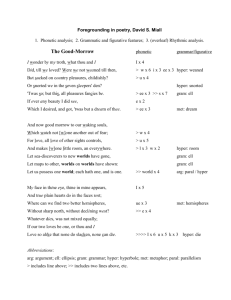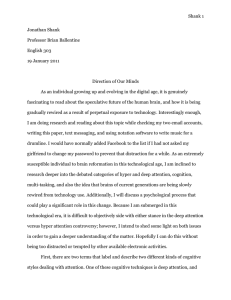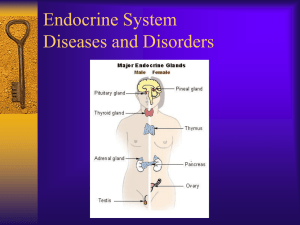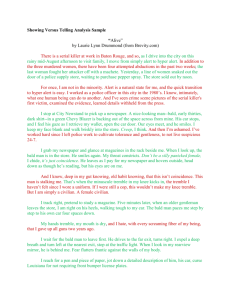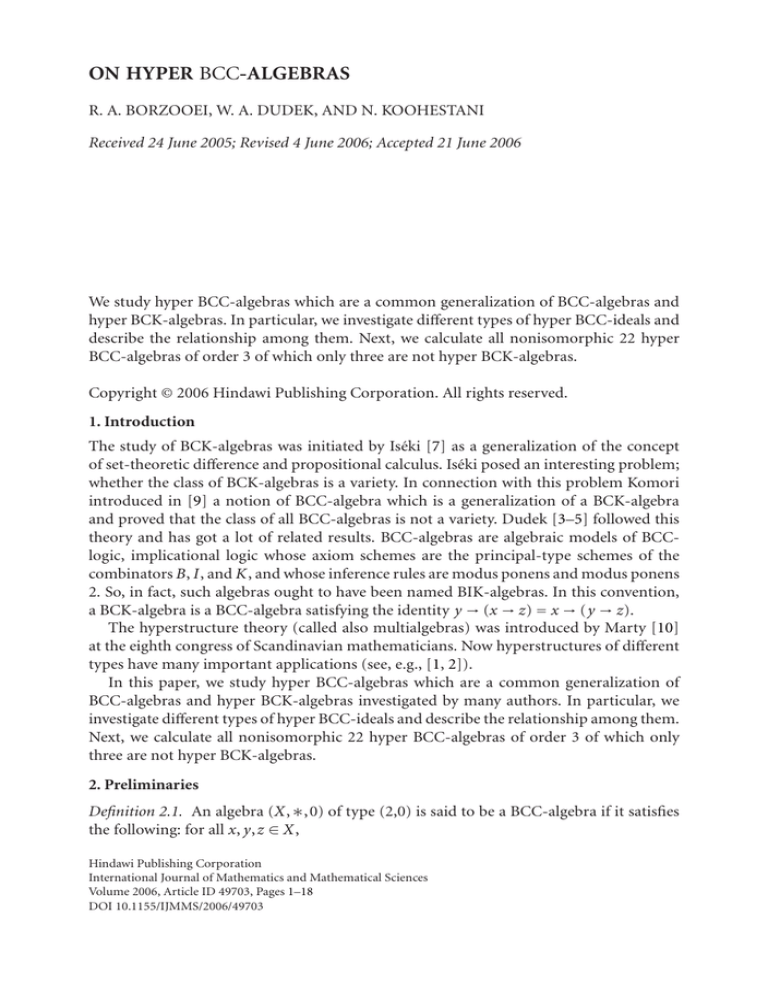
ON HYPER BCC-ALGEBRAS
R. A. BORZOOEI, W. A. DUDEK, AND N. KOOHESTANI
Received 24 June 2005; Revised 4 June 2006; Accepted 21 June 2006
We study hyper BCC-algebras which are a common generalization of BCC-algebras and
hyper BCK-algebras. In particular, we investigate different types of hyper BCC-ideals and
describe the relationship among them. Next, we calculate all nonisomorphic 22 hyper
BCC-algebras of order 3 of which only three are not hyper BCK-algebras.
Copyright © 2006 Hindawi Publishing Corporation. All rights reserved.
1. Introduction
The study of BCK-algebras was initiated by Iséki [7] as a generalization of the concept
of set-theoretic difference and propositional calculus. Iséki posed an interesting problem;
whether the class of BCK-algebras is a variety. In connection with this problem Komori
introduced in [9] a notion of BCC-algebra which is a generalization of a BCK-algebra
and proved that the class of all BCC-algebras is not a variety. Dudek [3–5] followed this
theory and has got a lot of related results. BCC-algebras are algebraic models of BCClogic, implicational logic whose axiom schemes are the principal-type schemes of the
combinators B, I, and K, and whose inference rules are modus ponens and modus ponens
2. So, in fact, such algebras ought to have been named BIK-algebras. In this convention,
a BCK-algebra is a BCC-algebra satisfying the identity y → (x → z) = x → (y → z).
The hyperstructure theory (called also multialgebras) was introduced by Marty [10]
at the eighth congress of Scandinavian mathematicians. Now hyperstructures of different
types have many important applications (see, e.g., [1, 2]).
In this paper, we study hyper BCC-algebras which are a common generalization of
BCC-algebras and hyper BCK-algebras investigated by many authors. In particular, we
investigate different types of hyper BCC-ideals and describe the relationship among them.
Next, we calculate all nonisomorphic 22 hyper BCC-algebras of order 3 of which only
three are not hyper BCK-algebras.
2. Preliminaries
Definition 2.1. An algebra (X, ∗,0) of type (2,0) is said to be a BCC-algebra if it satisfies
the following: for all x, y,z ∈ X,
Hindawi Publishing Corporation
International Journal of Mathematics and Mathematical Sciences
Volume 2006, Article ID 49703, Pages 1–18
DOI 10.1155/IJMMS/2006/49703
2
On hyper BCC-algebras
(I) ((x ∗ y) ∗ (z ∗ y)) ∗ (x ∗ z) = 0,
(II) x ∗ 0 = x,
(III) x ∗ x = 0,
(IV) 0 ∗ x = 0,
(V) x ∗ y = 0 and y ∗ x = 0 imply x = y.
Definition 2.2. By a hyper BCK-algebra, it is meant a nonempty set H endowed with a
hyperoperation “◦” and a constant “0” satisfying the following axioms:
(HK1 ) (x ◦ z) ◦ (y ◦ z) x ◦ y,
(HK2 ) (x ◦ y) ◦ z = (x ◦ z) ◦ y,
(HK3 ) x ◦ H {x},
(HK4 ) x y and y x imply x = y
for all x, y,z ∈ H, where x y is defined by 0 ∈ x ◦ y and for every A,B ⊆ H, A B is
defined by for all a ∈ A, there exists b ∈ B such that a b. In such case, “” is called the
hyperorder in H.
Proposition 2.3 (see [8]). In any hyper BCK-algebra H, for all x, y,z ∈ H, the following
hold:
(i) 0 ◦ 0 = {0},
(ii) 0 ◦ x = {0},
(iii) x ◦ 0 = {x}.
Definition 2.4. Let I be a nonempty subset of a hyper BCK-algebra H and 0 ∈ I. Then I is
said to be a weak hyper BCK-ideal of H if x ◦ y ⊆ I and y ∈ I imply x ∈ I for all x, y ∈ H,
hyper BCK-ideal of H if x ◦ y I and y ∈ I imply x ∈ I for all x, y ∈ H, strong hyper
BCK-ideal of H if (x ◦ y) ∩ I = ∅ and y ∈ I imply x ∈ I for all x, y ∈ H, hyper subalgebra
of H if x ◦ y ⊆ I for all x, y ∈ I.
3. Hyper BCC-algebras
Definition 3.1. By a hyper BCC-algebra, it is meant a nonempty set H endowed with a
hyperoperation “◦” and a constant 0 satisfying the following axioms:
(HC1 ) (x ◦ z) ◦ (y ◦ z) x ◦ y,
(HC2 ) 0 ◦ x = {0},
(HC3 ) x ◦ 0 = {x},
(HC4 ) x y and y x imply x = y
for all x, y,z ∈ H, where x y is defined by 0 ∈ x ◦ y and for every A,B ⊆ H, A B is
defined by for all a ∈ A, there exists b ∈ B such that a b. In such case, “” is called the
hyperorder in H.
Example 3.2. (i) Let (H, ∗,0) be a BCC-algebra and define a hyper operation “◦” on H
by x ◦ y = {x ∗ y } for all x, y ∈ H. Then (H, ◦) is a hyper BCC-algebra.
(ii) Let H = {0,1,2,3,...} and hyper operation “◦” on H is defined as follows:
⎧
⎨{0,x}
x◦y =⎩
{x }
if x ≤ y,
if x > y
for all x, y ∈ H. Then (H, ◦) is a hyper BCC-algebra.
(3.1)
R. A. Borzooei et al. 3
Table 3.1
◦1
0
1
2
3
0
{0}
{1}
{2}
{3}
1
{0}
{0}
{2}
{1,3}
2
{0}
{0}
{0,1}
{0,1,3}
3
{0}
{0}
{2}
{0,1,3}
Table 3.2
◦2
0
1
2
0
{0}
{1}
{2}
1
{0}
{0}
{2}
2
{0}
{0}
{0,1}
(iii) Let H1 = {0,1,2,3}, H2 = {0,1,2}, and hyper operations “◦1 ” and “◦2 ”, respectively, on H1 and H2 be defined as in Tables 3.1 and 3.2.
Then (H1 , ◦1 ) and (H2 , ◦2 ) are hyper BCC-algebras.
Theorem 3.3. Any hyper BCK-algebra is a hyper BCC-algebra.
Proof. The proof follows from (HK1 ), (HK4 ), and Proposition 2.3(ii) and (iii).
The converse of Theorem 3.3 is not true in general. As it is not difficult to see in
Example 3.2(iii) that H1 and H2 are hyper BCC-algebras but they are not hyper BCKalgebras because (2 ◦ 1) ◦ 2 = (2 ◦ 2) ◦ 1.
Definition 3.4. Hyper BCC-algebra H is called a proper hyper BCC-algebra if H is not a
hyper BCK-algebra.
Proposition 3.5. Let H be a hyper BCC-algebra. Then for all x, y,z ∈ H and A ⊆ H the
following statements hold:
(i) 0 ◦ 0 = {0},
(ii) 0 x,
(iii) x x,
(iv) x ◦ y {x},
(v) A ◦ 0 = A,
(vi) 0 ◦ A = {0},
(vii) x ◦ y = {0} implies x ◦ z y ◦ z.
Proof. (i) In (HC2 ), let x = 0. Then 0 ◦ 0 = {0}.
(ii) By (HC2 ), 0 ∈ 0 ◦ x and so 0 x.
(iii) In (HC1 ), let y = z = 0. Then by (i) and (HC3 ), we get that x x.
(iv) By (HC1 ), we conclude that (x ◦ y) ◦ (z ◦ y) x ◦ z. Now, let z = 0. Then by (HC2 )
and (HC3 ), we get that x ◦ y {x}.
(v) The proof follows by (HC3 ).
(vi) The proof follows by (HC2 ).
4
On hyper BCC-algebras
(vii) Let x ◦ y = {0}. Since by (HC1 ), (x ◦ z) ◦ (y ◦ z) x ◦ y = {0}, then for all a ∈
(x ◦ z) ◦ (y ◦ z), a 0 and so by (HC3 ) and (HC4 ), a = 0. Hence (x ◦ z) ◦ (y ◦ z) = {0}.
Now, it is easy to show that x ◦ z y ◦ z.
Theorem 3.6. Let H be a hyper BCC-algebra. Then H is a hyper BCK-algebra if and only
if (x ◦ y) ◦ z = (x ◦ z) ◦ y holds for all x, y,z ∈ H.
Proof. Of course, every hyper BCK-algebra satisfies this identity. Conversely, in a hyper
BCC-algebra satisfying this identity, for all x, y ∈ H, we have
x ◦ y {x} ⇐⇒ x ◦ H {x}.
(3.2)
Proposition 3.5(iv) completes the proof.
Theorem 3.7. Let H be a hyper BCC-algebra. Then the set
S(H) = x ∈ H : x ◦ x = {0}
(3.3)
is a BCC-algebra.
Proof. Let H be a hyper BCC-algebra and S(H) = {x ∈ H : x ◦ x = {0}}. We claim that for
all y,z ∈ S(H), | y ◦ z| = 1. Let there exist y,z ∈ S(H) such that | y ◦ z| > 1. Hence there
exist a,b ∈ y ◦ z such that a = b. Since by (HC1 ) and hypothesis,
a ◦ b, b ◦ a ⊆ (y ◦ z) ◦ (y ◦ z) y ◦ y = {0}.
(3.4)
Then a ◦ b {0} and b ◦ a {0} and so a b and b a. Hence by (HC4 ), a = b which
is a contradiction. Therefore, for all y,z ∈ S(H), y ◦ z is a singleton set and so S(H) is a
BCC-algebra.
Theorem 3.8. Let H be a hyper BCC-algebra such that for all x, y ∈ H,
x ◦ (x ◦ y) { y }.
(3.5)
Then, H is a BCK-algebra.
Proof. By hypothesis and (HC3 ), x ◦ x = x ◦ (x ◦ 0) 0 for all x ∈ H and so x ◦ x = {0}
for all x ∈ H. Hence by Theorem 3.7, H is a BCC-algebra. Now, since by hypothesis,
x ◦ (x ◦ y) { y } or equivalently, (x ◦ (x ◦ y)) ◦ y = 0 (since H is a BCC-algebra), then by
[4, Corollary 1], H is a BCK-algebra.
Generalizing the construction used in [4, 6], we can prove the following.
R. A. Borzooei et al. 5
Theorem 3.9. Let (H1 , ◦1 ) be a (proper) hyper BCC-algebra, a ∈ H1 , and H = H1 ∪ {a}.
Define the hyper operation “◦” on H as follows:
⎧
⎪
⎪
⎪{a}
⎪
⎪
⎪
⎪
⎪
⎪{x}
⎪
⎪
⎨
x ◦ y = ⎪{0,a}
⎪
⎪
⎪
⎪
⎪
{0 }
⎪
⎪
⎪
⎪
⎪
⎩x ◦ y
1
if x = a, y = 0,
if x ∈ H1 , y = a,
if x = y = a,
(3.6)
if x = a, y ∈ H1 − {0},
if x, y ∈ H1 ,
for all x, y ∈ H. Then (H, ◦) is a (proper) hyper BCC-algebra.
Proof. The proof of (HC2 ), (HC3 ), and (HC4 ) is clear. So, we verify only the axiom (HC1 ).
Let x, y,z ∈ H. We consider two cases for x.
Case 1 ((x ∈ H1 )). Then y ∈ H1 or y = a.
(1a) Let y ∈ H1 . If z ∈ H1 , then the proof is clear. If z = a, then
(x ◦ z) ◦ (y ◦ z) = (x ◦ a) ◦ (y ◦ a) = x ◦ y = x ◦1 y x ◦1 y = x ◦ y.
(3.7)
(1b) Let y = a. If z = 0, then
(x ◦ y) ◦ (y ◦ z) = (x ◦ 0) ◦ (a ◦ 0) = x ◦1 0 ◦ {a} = x ◦ a = {x} {x} = x ◦ a = x ◦ y.
(3.8)
If z ∈ H1 − {0}, then
(x ◦ z) ◦ (y ◦ z) = (x ◦ z) ◦ (a ◦ z) = x ◦1 z ◦ 0 = x ◦1 z {x} = x ◦ a = x ◦ y.
(3.9)
If z = a, then
(x ◦ z) ◦ (y ◦ z) = (x ◦ a) ◦ (a ◦ a) = a ◦ {0,a} = {0,a} {a} = x ◦ a = x ◦ y.
(3.10)
Case 2 ((x = a)). Then, as in the previous case, y ∈ H1 or y = a.
(2a) Let y ∈ H1 . If z = 0, then
(x ◦ z) ◦ (y ◦ z) = (a ◦ 0) ◦ (y ◦ 0) = a ◦ y a ◦ y = x ◦ y.
(3.11)
If z ∈ H1 − {0}, then
(x ◦ z) ◦ (y ◦ z) = (a ◦ z) ◦ (y ◦ z) = 0 ◦ (y ◦ z) = {0} a ◦ y = x ◦ y.
(3.12)
If z = a, then
(x ◦ z) ◦ (y ◦ z) = (a ◦ a) ◦ (y ◦ a) = {0,a} ◦ y = {0} ∪ a ◦ y a ◦ y = x ◦ y.
(3.13)
(2b) Let y = a. If z = 0, then
(x ◦ z) ◦ (y ◦ z) = (a ◦ 0) ◦ (a ◦ 0) = a ◦ a = {0,a} {0,a} = a ◦ a = x ◦ y.
(3.14)
6
On hyper BCC-algebras
If z ∈ H1 − {0}, then
(x ◦ z) ◦ (y ◦ z) = (a ◦ z) ◦ (a ◦ z) = 0 ◦ 0 = {0} {0,a} = a ◦ a = x ◦ y.
(3.15)
If z = a, then
(x ◦ z) ◦ (y ◦ z) = (a ◦ a) ◦ (a ◦ a) = {0,a} {0,a} = a ◦ a = x ◦ z.
(3.16)
Hence H satisfies the axiom of (HC1 ). Therefore, (H, ◦) is a hyper BCC-algebra.
Corollary 3.10. For any n ≥ 3, there exists at least one proper hyper BCC-algebra of order
n.
Proof. The proof follows from Theorem 3.9 and Example 3.2(iii).
Theorem 3.11. Let α be a transfinite cardinal number. Then there exists a hyper BCCalgebra H such that Card(H) = α.
Proof. Since α is a transfinite cardinal number, then there exists an infinite set A such
that Card(A) = α. Now, let C = {x0 ,x1 ,x2 ,x3 ,...} be an infinite countable subset of A. Let
hyperoperation “” on C be defined as follows:
⎧
⎨ x0 ,xi
xi x j = ⎩ xi
if i ≤ j,
(3.17)
if i > j
for all xi , y j ∈ C. Similar to Example 3.2(ii), we can see that (C, ,x0 ) is a hyper BCCalgebra. If Card(A) = Card(C), the proof is complete. Now, let Card(C) < Card(A). Let
Ω=
Hi , ◦i ,x0 | Hi , ◦i ,x0 is a hyper BCC-algebra, C ⊆ Hi ⊆ A, ◦i |C = .
(3.18)
Since (C, ,x0 ) ∈ Ω, then Ω = ∅. Now, we define the relation “⊆” on Ω as follows:
Hi , ◦i ,x0 ⊆ H j , ◦ j ,x0 ⇐⇒ Hi ⊆ H j ,
◦ j |Hi = ◦i .
(3.19)
Then (Ω, ⊆) is a partially ordered set. Now, let {(Hk , ◦k ,x0 )}k∈I be a totally ordered
set in Ω and H = k∈I Hk . For all x, y ∈ H , there exists Htxy ∈ {(Hk , ◦k ,x0 )}k∈I such
that x, y ∈ Htxy and so we can define hyperoperation “◦” on H by x ◦ y = x ◦txy y. It is
easy to prove that (H , ◦,x0 ) is a hyper BCC-algebra and so H ∈ Ω. Hence by Zoren’s
lemma, Ω has a maximal element. Let (H, ◦ ) be a maximal element of Ω. If H = A, the
proof is complete. Let H = A. Hence, there exists an element a ∈ A such that a ∈ H. Now,
hyperoperation “◦” on H ∪ {a} is defined as follows:
⎧
⎪
{ a}
⎪
⎪
⎪
⎪
⎪
⎪
⎪
⎪{x}
⎪
⎪
⎨
x ◦ y = ⎪ x0 ,a
⎪
⎪
⎪
⎪
⎪
x0
⎪
⎪
⎪
⎪
⎪ ⎩
x◦ y
if x = a, y = x0 ,
if x ∈ H, y = a,
if x = y = a,
if x = a, y ∈ H − x0 ,
if x, y ∈ H
(3.20)
R. A. Borzooei et al. 7
for all x, y ∈ H. Then by Theorem 3.9, (H ∪ {a}, ◦,x0 ) is a hyper BCC-algebra and so
belongs to Ω, which is a contradiction, because H is maximal in Ω. Hence, H = A and so
Card(H) = α.
Corollary 3.12. For all transfinite cardinal number α, there are infinite hyper BCC-algebras of order α.
Proof. By Theorem 3.11, there exists a hyper BCC-algebra H such that Card(H) = α.
Now, let A = {a1 ,a2 ,a3 ,...} be an infinite set such that H ∩ A = ∅. By Theorem 3.9,
H1 = H ∪ {a1 } is a hyper BCC-algebra of order α + 1. Since α is a transfinite cardinal
number, then α + 1 = α. Hence, Card(H1 ) = α. Similarly, H2 = H1 ∪ {a2 } is a hyper BCCalgebra of order α + 1 = α. By continuing this process, we get infinite hyper BCC-algebras
of order α.
4. Hyper BCC-ideals
Definition 4.1. A subset I of a hyper BCC-algebra H such that 0 ∈ I is called the following:
(i) a hyper BCC-ideal of type 1, if
(x ◦ y) ◦ z I,
y ∈ I =⇒ x ◦ z ⊆ I,
(4.1)
y ∈ I =⇒ x ◦ z ⊆ I,
(4.2)
y ∈ I =⇒ x ◦ z I,
(4.3)
y ∈ I =⇒ x ◦ z I.
(4.4)
(ii) a hyper BCC-ideal of type 2, if
(x ◦ y) ◦ z ⊆ I,
(iii) a hyper BCC-ideal of type 3, if
(x ◦ y) ◦ z I,
(iv) a hyper BCC-ideal of type 4, if
(x ◦ y) ◦ z ⊆ I,
Theorem 4.2. In any hyper BCC-algebra, the following statements are valid.
(i) Any hyper BCC-ideal of type 1 is a hyper BCC-ideal of types 2 and 3.
(ii) Any hyper BCC-ideal of type 2 is a hyper BCC-ideal of type 4.
(iii) Any hyper BCC-ideal of type 3 is a hyper BCC-ideal of type 4.
(iv) Any hyper BCC-ideal of type 1 is a hyper BCK-ideal.
(v) Any hyper BCC-ideal of type 2 is a weak hyper BCK-ideal.
Proof. The statements (i), (ii), and (iii) are clear. So, we prove only (iv) and (v).
(iv) Let I be a hyper BCC-ideal of type 1, x ◦ y I, and y ∈ I. Hence, by Proposition
3.5(v), we obtain (x ◦ y) ◦ 0 = x ◦ y I. But y ∈ I, so, applying the hypothesis and
(HC3 ), we get {x} = x ◦ 0 ⊆ I. This shows that I is a hyper BCK-ideal of H.
(v) The proof of (iv) is analogous.
8
On hyper BCC-algebras
Table 4.1
◦
a
{0}
{0}
{b}
0
{0}
{a}
{b}
0
a
b
b
{0}
{0}
{0,a,b}
Table 4.2
◦1
0
a
b
c
0
a
b
c
{0}
{0}
{0}
{0}
{a}
{0}
{0}
{0}
{b}
{a}
{0}
{0}
{c}
{b}
{a,b}
{0,a}
Table 4.3
◦2
0
a
b
c
0
{0}
{a}
{b}
{c}
a
{0}
{0,a}
{b}
{b}
b
{0}
{0}
{0}
{b}
c
{0}
{0}
{0}
{0,a}
Table 4.4
◦3
0
a
b
c
0
a
b
c
{0}
{0}
{0}
{0}
{a}
{0,a}
{0}
{0}
{b}
{b}
{0,b}
{0,b}
{c}
{b}
{a,b}
{0,a,b}
Example 4.3. (i) In a hyper BCC-algebra H defined in Example 3.2(i), every BCC-ideal I
of a BCC-algebra (H, ∗,0) is a hyper BCC-ideal of types 1, 2, 3, and 4 of a hyper BCCalgebra (H, ◦,0).
(ii) Let H = {0,a,b}. Consider Table 4.1.
Then H is a proper hyper BCC-algebra (since (b ◦ a) ◦ b = (b ◦ b) ◦ a). Moreover, I1 =
{0,a} is a hyper BCC-ideal of types 1, 2, 3 and 4 while I2 = {0,b} is a hyper BCC-ideal of
types 3 and 4 but it is not a hyper BCC-ideal of types 1 and 2 (since (a ◦ b) ◦ 0 ⊆ I2 and
b ∈ I2 but a ◦ 0 ⊆ I2 , then I2 is not a hyper BCC-ideal of type 2 and so by Theorem 4.2(i)
it is not a hyper BCC-ideal of type 1).
(iii) Define on H = {0,a,b,c} the following three hyperoperations, Tables 4.2, 4.3, and
4.4.
Then, as it is not difficult to verify, (H, ◦1 ), (H, ◦2 ), and (H, ◦3 ) are hyper BCC-algebras.
These algebras are proper BCC-algebras because (c ◦ a) ◦ b = (c ◦ b) ◦ a. In (H, ◦1 ), I =
{0,b} is a hyper BCC-ideal of type 4 but it is not a hyper BCC-ideal of type 3 (since
R. A. Borzooei et al. 9
4
∗
3
2
Weak hyper BCK-ideal
1
∗
Hyper BCK-ideal
∗: if H is a hyper BCK-algebra.
Figure 4.1
(c ◦ b) ◦ 0 I and b ∈ I but c ◦ 0 I). In (H, ◦2 ), I = {0,a} is a hyper BCK-ideal of H
but it is not a hyper BCC-ideal of type 1 (since (c ◦ a) ◦ b I and a ∈ I but c ◦ b ⊆ I). In
(H, ◦3 ), I = {0,a,c} is a hyper BCC-ideal of type 2 but it is not a hyper BCC-ideal of type
1 (since (b ◦ a) ◦ a I and a ∈ I but b ◦ a ⊆ I).
Open problem 4.4. Is there a proper hyper BCC-algebra in which the concepts of a hyper
BCC-ideal of type 2 and a weak hyper BCK-ideal are different? We think that in hyper
BCC-algebras of orders 3 and 4, these concepts are equivalent(?).
Theorem 4.5. Let H be a hyper BCK-algebra and let I be a nonempty subset of H. Then,
(i) I is a hyper BCC-ideal of type 1 if and only if I is a hyper BCK-ideal of H,
(ii) I is a hyper BCC-ideal of type 2 if and only if I is a weak hyper BCK-ideal of H.
Proof. (i) “If ” part. By Theorem 4.2(iv).
“Only if ” part. Let I be a hyper BCK-ideal of H, (x ◦ y) ◦ z I and y ∈ I. By (HK2 ),
(x ◦ z) ◦ y = (x ◦ y) ◦ z I and so for each a ∈ x ◦ z, a ◦ z I. Since z ∈ I and I is a hyper
BCK-ideal of H, then a ∈ I and so x ◦ y ⊆ I. Hence I is a hyper BCC-ideal of type 1.
(ii) The proof is similar to the proof of (i).
Now, we summarize Theorems 4.2 and 4.5 in Figure 4.1.
Definition 4.6. A nonempty subset I of a hyper BCC-algebra H satisfies the closed condition if x y and y ∈ I imply x ∈ I.
Theorem 4.7. A nonempty subset I of a hyper BCC-algebra H satisfying the closed condition is a hyper BCC-ideal of type i, for 1 ≤ i ≤ 4 if and only if I is a hyper BCC-ideal of type
j, for 1 ≤ j ≤ 4.
Proof. Let I satisfy the closed condition. It is easy to prove that for any subset A of H if
A I, then A ⊆ I. Hence the proof is clear.
10
On hyper BCC-algebras
Theorem 4.8. Any strong hyper BCK-ideal of a hyper BCC (BCK)-algebra is its hyper
subalgebra.
Proof. Let I be a strong hyper BCK-ideal of H and x, y ∈ I. By Proposition 3.5(iv), x ◦
y {x} and so for each a ∈ x ◦ y, a x and so 0 ∈ a ◦ x. Since 0 ∈ I, then a ◦ x ∩ I = ∅.
Now, since x ∈ I and I is a strong hyper BCK-ideal of H, then a ∈ I and so x ◦ y ⊆ I.
Hence I is a hyper subalgebra of H.
5. Classification of hyper BCC-algebras of order 3
Based on the results of the previous section, we are to able to calculate of all nonisomorphic hyper BCC-algebras of order 3. For simplicity, let in this section H be a hyper
BCC-algebra and let H = {0,a,b}.
We will say that this hyper BCC-algebra is linear if all its elements are comparable, that
is, if 0 a b or 0 b a. Any other hyper BCC-algebra H will be called nonlinear.
Of course, in any case, we have 0 a and 0 b.
Theorem 5.1. There are only three nonisomorphic nonlinear hyper BCC-algebras of order
3, which are not proper hyper BCC-algebras.
Proof. In a nonlinear hyper BCC-algebra H, we have the following:
(1) x ∈ y ◦ x for all x, y ∈ H such that x = y,
(2) a ◦ b = {a} and b ◦ a = {b},
(3) a ◦ a = {0} or {0,a} and b ◦ b = {0} or {0,b}.
Indeed, if x = y and x ∈ y ◦ x, then x = 0, because x = 0 implies y = 0 and 0 ∈ y ◦ 0 =
{ y }, whence y = 0, which is impossible. By Proposition 3.5(iv), y ◦ x { y }. Therefore,
x y. But x = 0, so, a b or b a, which is impossible by the assumption. This proves
(1).
(2) From a b, it follows that 0 ∈ a ◦ b. So, a ◦ b cannot be equal to {0}, {0,a}, {0,b},
or {0,a,b}. Because by (1), we have also b ∈ a ◦ b, then a ◦ b cannot be equal to {b} or
{a,b}. Thus a ◦ b = {a}. Similarly, we can prove that b ◦ a = {b}.
(3) For a ◦ a, the following cases are possible: {0}, {0,a}, {0,b}, or {0,a,b}. In the
case a ◦ a = {0,b} or a ◦ a = {0,a,b}, by Proposition 3.5(iv), we get a ◦ a a. But by
the assumption, b ∈ a ◦ a, whence b a, which is impossible. So, a ◦ a = {0,a,b} and
a ◦ a = {0,b}. This means that a ◦ b = {0} or a ◦ b = {0,a}. Similarly, we can show that
b ◦ b = {0} or b ◦ b = {0}, {0,b}.
Therefore, by (1), (2), and (3), we conclude that there are four nonlinear hyper BCCalgebras containing three elements. Their hyperoperations are given by Tables 5.1, 5.2,
5.3, and 5.4.
But (H, ◦2 ) and (H, ) are isomorphic. The isomorphism f : (H, ◦) → (H, ◦2 ) is
defined by f (0) = 0, f (a) = b and f (b) = a. Other nonlinear hyper BCC-algebras are
not isomorphic. It is clear that they are not proper hyper BCC-algebras.
Theorem 5.2. There are no linear hyper BCC-algebras of order 3 containing two proper
hyper BCK-ideals.
Proof. Suppose that there is a linear hyper BCC-algebra H of order 3 that has two proper
hyper BCK-ideals. Then I1 = {0,a} and I2 = {0,b} must be proper hyper BCK-ideals. Let
R. A. Borzooei et al.
11
Table 5.1
◦1
0
a
b
0
{0}
{a}
{b}
a
{0}
{0}
{b}
b
{0}
{a}
{0}
Table 5.2
◦2
0
a
b
0
a
b
{0}
{0}
{0}
{a}
{0}
{a}
{b}
{b}
{0,b}
Table 5.3
◦3
0
a
b
0
a
b
{0}
{0}
{0}
{a}
{0,a}
{a}
{b}
{b}
{0,b}
Table 5.4
0
a
b
0
{0}
{a}
{b}
a
{0}
{0,a}
{b}
b
{0}
{a}
{0}
a b. Then a ◦ b is equal to {0}, {0,a}, {0,b}, or {0,a,b}. In all these cases, a ◦ b I2 .
Since I2 is a hyper BCK-ideal of H and b ∈ I2 , so, a ∈ I2 , which is impossible. For b a,
we obtain a similar contradiction.
Theorem 5.3. There are 12 nonisomorphic linear hyper BCC-algebras of order 3 containing
only one proper hyper BCK-ideal and this ideal is strong too. Only two such hyper BCCalgebras are proper.
Proof. Without loss of generality, let I1 = {0,a} be the proper strong hyper BCK-ideal of
a linear hyper BCC-algebra H. Then a b or b a. For b a, we have 0 ∈ b ◦ a, which
gives b ◦ a ∩ I1 = ∅. But I1 is a strong hyper BCK ideal, so, a ∈ I1 implies b ∈ I1 , which
is impossible. Hence, a b and b a. Thus b ◦ a is equal to {a}, {b}, or to {a,b}. If
b ◦ a = {a}, then b ◦ a I1 , whence b ∈ I1 , which is not true. Therefore, b ◦ a = {a}. In
the case b ◦ a = {a,b}, we have b ◦ a ∩ I1 = ∅, consequently, b ∈ I1 , because I1 is strong.
This also is impossible. Thus it must be b ◦ a = {b}. Moreover, a b implies 0 ∈ a ◦ b.
Thus a ◦ b is equal to one of the sets {0}, {0,a}, {0,b}, {0,a,b}. If a ◦ b = {0,b}, then,
by Proposition 3.5(iv), {0,b} = a ◦ b a, whence b a which is not true. For a ◦ b =
12
On hyper BCC-algebras
Table 5.5
1
0
a
b
0
{0}
{a}
{b}
a
{0}
{0}
{b}
b
{0}
{0,a}
{0}
Table 5.6
2
0
a
b
0
{0}
{a}
{b}
a
{0}
{0}
{b}
b
{0}
{0,a}
{0,a}
Table 5.7
3
0
a
b
0
a
b
{0}
{0}
{0}
{a}
{0}
{0,a}
{b}
{b}
{0,b}
Table 5.8
4
0
a
b
0
a
b
{0}
{0}
{0}
{a}
{0}
{0,a}
{b}
{b}
{0,a,b}
{0,a,b}, we obtain the similar contradiction. Thus a ◦ b = {0} or {0,a}. To compute a ◦ a,
observe that a ◦ a can be equal to one of the sets {0}, {0,a}, {0,b}, or {0,a,b}. If a ◦ a =
{0,b} or {0,a,b}, then a ◦ a a implies b a, which is impossible. So, a ◦ a = {0} or
{0,a}. Furthermore, b ◦ b is equal to {0}, {0,a}, {0,b}, or {0,a,b}. This means that totally
we have 2 × 2 × 4 = 16 different cases for H.
Consider Tables 5.5, 5.6, 5.7, and 5.8.
In (H, i ),1 ≤ i ≤ 4, we have (a ◦ b) ◦ (a ◦ b) a ◦ a. Thus (H, i ) are not hyper BCCalgebras.
The other 12 cases are presented in Tables 5.9, 5.10, 5.11, 5.12, 5.13, 5.14, 5.15, 5.16,
5.17, 5.18, 5.19, and 5.20.
It is not difficult to verify that hyperstructures defined by these tables are hyper BCCalgebras. Because the nonidentity homomorphism f from (H, ◦i ) onto (H, ◦ j ), i = j, and
4 ≤ i, j ≤ 15, is defined by f (0) = 0, f (a) = b, f (b) = a, then these 12 hyper BCC-algebras
are not isomorphic. Only hyper BCC-algebras (H, ◦4 ) and (H, ◦5 ) are proper. In these
hyper BCC-algebras, we have (b ◦ a) ◦ b = (b ◦ b) ◦ a.
R. A. Borzooei et al.
Table 5.9
◦4
0
a
b
0
{0}
{a}
{b}
a
{0}
{0}
{b}
b
{0}
{0}
{0,a}
Table 5.10
◦5
0
a
b
0
{0}
{a}
{b}
a
{0}
{0}
{b}
b
{0}
{0}
{0,a,b}
Table 5.11
◦6
0
a
b
0
a
b
{0}
{0}
{0}
{a}
{0}
{0}
{b}
{b}
{0}
Table 5.12
◦7
0
a
b
0
a
b
{0}
{0}
{0}
{a}
{0}
{0}
{b}
{b}
{0,b}
Table 5.13
◦8
0
a
b
0
a
b
{0}
{0}
{0}
{a}
{0,a}
{0}
{b}
{b}
{0}
Table 5.14
◦9
0
a
b
0
a
b
{0}
{0}
{0}
{a}
{0,a}
{0,a}
{b}
{b}
{0}
Table 5.15
◦10
0
a
b
0
a
b
{0}
{0}
{0}
{a}
{0,a}
{a}
{b}
{b}
{0,a}
13
14
On hyper BCC-algebras
Table 5.16
◦11
0
a
b
0
{0}
{a}
{b}
a
{0}
{0,a}
{b}
b
{0}
{0}
{0,b}
Table 5.17
◦12
0
a
b
0
a
b
{0}
{0}
{0}
{a}
{0,a}
{a}
{b}
{b}
{0,a,b}
Table 5.18
◦13
0
a
b
0
a
b
{0}
{0}
{0}
{a}
{0,a}
{0,a}
{b}
{b}
{0,b}
Table 5.19
◦14
0
a
b
0
{0}
{a}
{b}
a
{0}
{0,a}
{b}
b
{0}
{0,a}
{0,a}
Theorem 5.4. There are four nonisomorphic linear hyper BCK-algebras of order 3 containing only one proper hyper BCK-ideal and this ideal is not strong. One of them is a proper
BCC-algebra.
Proof. Without loss of generality, let I1 = {0,a} be the proper hyper BCK-ideal of H
which is not strong. Since H is linear, then b a or a b. If b a, then 0 ∈ b ◦ a
and so b ◦ a = {0} or {0,a} or {0,b}, or {0,a,b}. Since b a, then in any of the above
cases, b ◦ a I1 . Now, since a ∈ I1 and I1 is a hyper BCK-ideal of H, then b ∈ I1 which is
impossible. Hence a b and so 0 ∈ b ◦ a. Therefore, b ◦ a is equal to {a}, {b} , or {a,b}.
If b ◦ a ={a}, then b ◦ a I1 = {0,a}. Since a ∈ I1 and I1 is a hyper BCK-ideal, we get
b ∈ I1 , which is not true. In the case b ◦ a = {b}, I1 is a strong hyper BCK-ideal, because
b ◦ a ∩ I1 = b ◦ 0 ∩ I1 = ∅. This is a contradiction. Thus it must be b ◦ a ={a,b}.
R. A. Borzooei et al.
15
Table 5.20
◦15
0
a
b
0
{0}
{a}
{b}
a
{0}
{0,a}
{b}
b
{0}
{0,a}
{0,a,b}
Table 5.21
◦16
0
{0}
{a}
{b}
0
a
b
a
{0}
{0,a}
{a,b}
b
{0}
{0,a}
{0,b}
Table 5.22
◦17
0
a
b
0
{0}
{a}
{b}
a
{0}
{0,a}
{a,b}
b
{0}
{0,a}
{0,a,b}
Next, similarly as in the proof of Theorem 5.3, we can show that a ◦ a is equal to {0} or
{0,a}, a ◦ b is equal to {0} or {0,a}, and b ◦ b is equal to {0}, {0,a}, {0,b}, or {0,a,b}.
Thus there are 2 × 2 × 4 = 16 different cases for H.
(i) Let a ◦ a ={0}. If a ◦ b ={0}, b ◦ b ={0}, or b ◦ b = {0,a}, then
(b ◦ a) ◦ (b ◦ a) b ◦ b.
(5.1)
If a ◦ b = {0,a}, then we have
(a ◦ b) ◦ (a ◦ b) a ◦ a.
(5.2)
This means that in these six cases, obtained hyperstructures are not hyper BCCalgebras.
(ii) Let a ◦ a = {0,a}. If a ◦ b ={0}, then
(a ◦ a) ◦ (b ◦ a) a ◦ b.
(5.3)
If a ◦ b ={a} and b ◦ b ={0}, or b ◦ b = {0,a}, then
(b ◦ a) ◦ (b ◦ a) b ◦ b.
(5.4)
So, in these cases, we do not obtain a hyper BCC-algebra too. In the remaining four
cases, we obtain hyperstructures in Tables 5.21, 5.22, 5.23, and 5.24.
Direct computations show that these four hyperstructures are hyper BCC-algebras. It
is clear that these hyper BCC-algebras are not isomorphic. Only the last hyperstructure is
not a hyper BCK-algebra. Indeed, in (H, ◦19 ), we have (b ◦ a) ◦ b = (b ◦ b) ◦ a.
16
On hyper BCC-algebras
Table 5.23
◦18
0
a
b
0
{0}
{a}
{b}
a
{0}
{0}
{a,b}
b
{0}
{0}
{0,a,b}
Table 5.24
◦19
0
a
b
0
{0}
{a}
{b}
a
{0}
{0}
{a,b}
b
{0}
{0}
{0,b}
Theorem 5.5. There are three nonisomorphic and nonproper linear hyper BCC-algebras of
order 3 without proper hyper BCK-ideals.
Proof. Without loss of generality, we let a b. Then 0 ∈ a ◦ b and so a ◦ b is equal to
one of the sets {0}, {0,a}, {0,b}, or {0,a,b}. If a ◦ b = {0,b}, then by Proposition 2.3,
{0,b} = a ◦ b {a}, thus b a which is not true. If a ◦ b = {0,a,b}, then similarly, we
obtain a contradiction b a. Thus a ◦ b = {0} or {0,a}. Clearly, a ◦ a can be equal to one
of the sets {0}, {0,a}, {0,b}, or {0,a,b}. If a ◦ a = {0,b} or {0,a,b}, then since a ◦ a a,
we get that b a which is impossible. Thus a ◦ a = {0} or {0,a}. Also b ◦ b is equal to one
of the sets {0}, {0,a}, {0,b}, or {0,a,b}. Furthermore, b ◦ a is equal to one of the sets {a},
{b}, or {a,b}. If b ◦ a = {b}, then similar to the proof of Theorem 5.4, we conclude that I1
is strong, which is a contradiction. If b ◦ a ={a,b}, then all of hyper BCK-algebras which
are obtained are the same as Theorem 5.4. But each of these kinds of hyper BCK-algebras
has a proper BCK-ideal I1 = {0,a}, while by hypothesis, the involved hyper BCK-algebras
have not a proper BCK-ideal. So b ◦ a = {a,b} and we must have b ◦ a = {a}. Thus we
have 2 × 2 × 4 = 16 different possibilities.
(i) Let a ◦ a = {0}. If a ◦ b = {0} and b ◦ b ={0,b}, or b ◦ b ={0,a,b}, then
(b ◦ b) ◦ (a ◦ b) b ◦ a.
(5.5)
(a ◦ b) ◦ (a ◦ b) a ◦ a.
(5.6)
If a ◦ b = {0,a}, then
Therefore, in the above six cases, we do not obtain a hyper BCC-algebra.
(ii) Let a ◦ a = {0,a}. If a ◦ b = {0}, then
(a ◦ a) ◦ (b ◦ a) a ◦ b.
(5.7)
If a ◦ b = {0,a} and b ◦ b is one of the sets {0,b} or {0,a,b}, then
(b ◦ b) ◦ (a ◦ b) b ◦ a.
(5.8)
R. A. Borzooei et al.
17
Table 5.25
◦20
0
a
b
a
{0}
{0}
{a}
0
{0}
{a}
{b}
b
{0}
{0}
{0}
Table 5.26
◦21
0
a
b
0
a
b
{0}
{0}
{0}
{a}
{0}
{0}
{b}
{a}
{0,a}
Table 5.27
◦22
0
a
b
0
{0}
{a}
{b}
a
{0}
{0,a}
{a}
b
{0}
{0,a}
{0,a}
Table 5.28
◦4
0
a
b
0
a
b
{0}
{0}
{0}
{a}
{0}
{0}
{b}
{b}
{0,a}
If a ◦ b = {0,a} and b ◦ b ={0}, then
(b ◦ a) ◦ (b ◦ a) b ◦ b.
(5.9)
Hence, in the above seven cases, we do not obtain a hyper BCC-algebra too. In the
remaining three cases, we obtain the following hyperstructures in Tables 5.25, 5.26, and
5.27.
It is not difficult to check that these hyperstructures are hyper BCC-algebras which are
not proper hyper BCC-algebras. Obviously, these hyper BCC-algebras are not isomor
phic.
Summarizing our calculations, we obtain the following corollaries.
Corollary 5.6. There are 22 nonisomorphic hyper BCC-algebras of order 3.
Corollary 5.7. There are only three proper nonisomorphic hyper BCC-algebras of order 3
in Tables 5.28, 5.29, and 5.30.
18
On hyper BCC-algebras
Table 5.29
◦5
0
a
b
0
{0}
{a}
{b}
a
{0}
{0}
{b}
b
{0}
{0}
{0,a,b}
Table 5.30
◦19
0
a
b
0
{0}
{a}
{b}
a
{0}
{0}
{a,b}
b
{0}
{0}
{0,b}
Acknowledgments
Authors would like to express their sincere thanks to the referees for their valuable suggestions and comments.
References
[1] P. Corsini, Prolegomena of Hypergroup Theory, 2nd ed., Aviani Editore, Tricesimo, 1993.
[2] P. Corsini and V. Leoreanu, Applications of Hyperstructure Theory, Advances in Mathematics
(Dordrecht), vol. 5, Kluwer Academic, Dordrecht, 2003.
[3] W. A. Dudek, On BCC-algebras, Logique et Analyse. Nouvelle Série 33 (1990), no. 129-130, 103–
111.
, On proper BCC-algebras, Bulletin of the Institute of Mathematics. Academia Sinica 20
[4]
(1992), no. 2, 137–150.
, The number of subalgebras of finite BCC-algebras, Bulletin of the Institute of Mathemat[5]
ics. Academia Sinica 20 (1992), no. 2, 129–135.
, On constructions of BCC-algebras, selected papers on BCK- and BCI-algebras 1 (1992),
[6]
93–96.
[7] K. Iséki, An algebra related with a propositional calculus, Proceedings of the Japan Academy 42
(1966), 26–29.
[8] Y. B. Jun, M. M. Zahedi, X. L. Xin, and R. A. Borzoei, On hyper BCK-algebras, Italian Journal of
Pure and Applied Mathematics (2000), no. 8, 127–136.
[9] Y. Komori, The class of BCC-algebras is not a variety, Mathematica Japonica 29 (1984), no. 3,
391–394.
[10] F. Marty, Sur une generalization de la notion de groupe, 8th Congres Math. Scandinaves, Stockholm, 1934, pp. 45–49.
R. A. Borzooei: Department of Mathematics, University of Sistan and Baluchestan, Zahedan, Iran
E-mail address: borzooei@hamoon.usb.ac.ir
W. A. Dudek: Institute of Mathematics and Computer Science, Wroclaw University of Technology,
50-370 Wroclaw, Poland
E-mail address: dudek@im.pwr.wroc.pl
N. Koohestani: Department of Mathematics, University of Sistan and Baluchestan, Zahedan, Iran
E-mail address: koohestani@hamoon.usb.ac.ir


